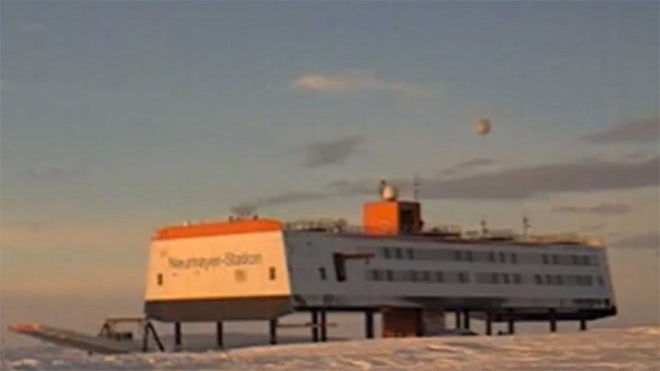Why the Chinchorro suddenly began to mummify their dead
Researchers in Chile, led by Pablo Marqueta, an ecologist with Universidad Católica de Chile have arrived at a new theory to explain why a culture that existed around seven thousand years ago suddenly began to mummify their dead.
The researchers have been examining the Chinchorro, hunter-gatherers that lived in the desert region of what is now northern Chile and southern Peru, from about 10,000 to 4,000 years ago. The mummies first date to 5050 BCE and continue to be made until about 1800 BCE. |  |
100,000 DPI Image Pushes Limits of Resolution
The Singapore-based team, who describe their work in a paper in Nature Nanotechnology, created pixels using tiny nanoscale posts, with silver and gold nanodiscs on top. The distance between these structures, and their diameter, sets the colour of light that they reflect.
As proof of concept, the researchers, based at Singpore’s Agency for Science, Technology and Research, printed a 50 x 50 micrometer image of Lena Söderberg, a Swedish model from a 1972 issue of Playboy magazine, often used in image processing experiments. |  |
Flying cars: Grounded reality or ready for take off?
Blade Runner. Back to the Future. The Fifth Element. Science fiction classics that all have one thing in common: flying cars.
Whether it’s gliding taxi cabs or hovering DeLoreans, Hollywood has embraced the idea of a vehicle that is as happy on the motorway as it is in the clouds. But away from the silver screen, this science fiction staple has failed to take off. Over the years, there have been ambitious and attempts – such as the Taylor Aerocar - but few would agree that the designs are in any way practical or user-friendly. But the ever increasing number of cars on the roads means that a vehicle that can soar into the skies remains an attractive option. |  |
Fukushima 'caused mutant butterflies' in Japan
Around 12 per cent of pale grass blue butterflies that were exposed to nuclear fallout as larvae immediately after the tsunami-sparked disaster had abnormalities, including smaller wings and damaged eyes, researchers said.
The insects were mated in a laboratory well outside the fallout zone and 18 per cent of their offspring displayed similar problems, said Joji Otaki, associate professor at Ryukyu University in Okinawa, southwestern Japan. That figure rose to 34 per cent in the third generation of butterflies, he said, even though one parent from each coupling was from an unaffected population. |  |
Imagine flying from New York to London in under an hour
Perhaps Han Solo said it best in Star Wars when, describing his hyper-fast smuggling spaceship the Millennium Falcon, he said, "It may not look like much, but it's got it where it counts."
While the Air Force might take exception to being likened to the Falcon, in reality the platypus-nosed X-51A Waverider hypersonic flight test vehicle really doesn't look like much. But it definitely has it where it counts. On Tuesday, the unmanned 25-foot-long vehicle will be dropped off of the wing of a converted B-52 bomber off the California coast and try to fly for 300 seconds at science fiction-like speeds of Mach 6, over 4,500 mph - fast enough to fly from New York to London in less than an hour. |  |
What Internet Habits Say About Mental Health

Consider two questions. First: Who are you? What makes you different from your peers, in terms of the things you buy, the clothes you wear, and the car you drive (or refuse to)? What makes you unique in terms of your basic psychological make-up—the part of you that makes you do the things you do, say the things you say, and feel the things you feel? And the second question: How do you use the internet?.
Twin satellites will study radiation around Earth
A pair of spacecraft in suits of armor will brave one of the toughest environments in space when they launch later this month to study radiation around Earth.
NASA's Radiation Belt Storm Probes (RBSP) will fly through the thick belts of charged particles that encircle our planet to try to understand these dynamic environments. To withstand the damage such harsh radiation can inflict, the satellites are shrouded in strong layers of shielding. |  |
NASA hopes successes will boost its support in Congress

WASHINGTON – The Curiosity rover's impressive arrival on Mars couldn't have come at a better time for NASA.
The agency, facing budget cuts, increased congressional scrutiny and questions about its direction since the shuttle program ended last year, has worked to remind skeptics the U.S. space program deserves continued support and investment.
The agency, facing budget cuts, increased congressional scrutiny and questions about its direction since the shuttle program ended last year, has worked to remind skeptics the U.S. space program deserves continued support and investment.
Hot stuff: CERN physicists create record-breaking subatomic soup
Get Guinness. Physics at CERN’s Large Hadron Collider have achieved the hottest manmade temperatures ever, by colliding lead ions to momentarily create a quark gluon plasma, a subatomic soup and unique state of matter that is thought to have existed just moments after the Big Bang.
The results come from the ALICE heavy-ion experiment (at right) — a lesser-known sibling to ATLAS and CMS, which produced the data that led to the announcement in July that the Higgs boson had been discovered. ALICE physicists, presenting on Monday at Quark Matter 2012 in Washington DC, say they have achieved a quark gluon plasma 38% hotter than a record 4 trillion degree plasma achieved in 2010 by a similar experiment at Brookhaven National Laboratory in New York, which had been anointed the Guinness record holder. |  |
Rooftop farms flourish in space-starved Hong Kong
On the rooftop of a tower block above the hustle and bustle of teeming Hong Kong, dedicated growers tend to their organic crops in a vegetable garden.
Against a backdrop of skyscrapers and jungle-clad hills, earth-filled boxes are spread out on the roof of the 14-storey building, where a wide variety of produce including cucumbers and potatoes are cultivated. It is one of several such sites that have sprung up in Hong Kong's concrete jungle, as the appetite for organic produce grows and people seek ways to escape one of the most densely populated places on earth. |  |
Marine research in the Brazilian rain forest
Until recent decades the Atlantic Rainforest covered a large area of today’s Brazil from Amazonas to present-day Argentina. In the 1970s, after years of deforestation, this rain forest was almost completely destroyed, mainly replaced by cattle pastures. This study reveals an unexpected aspect of deforestation.
Thorsten Dittmar's team and colleagues from Brazil and the USA show that the common practice of slash and burn left huge amounts of charcoal in the soil. This charcoal is washed out by rainfalls and transported by rivers into the Atlantic Ocean. The soluble fraction of charcoal is composed of extremely stable carbon compounds. The authors conclude that the amounts of these compounds dissolved in the ocean will increase due to human civilization. So far, the effects on marine microorganisms and the global carbon cycle are unknown. |  |
Source of Mysterious Pumice 'Raft' in Pacific Found, NASA Says
The source of an enormous floating mass of pumice spotted this week in the South Pacific Ocean off the coast of New Zealand has been discovered: NASA satellite images and other sleuthing science have pinpointed an erupting undersea volcano called the Havre Seamount as the culprit.
On Aug. 9, the HMNZS Canterbury ship observed the floating pumice "island" — measuring a whopping 300 miles (482 kilometers) in length and more than 30 miles (48 km) wide — along a voyage from Auckland to Raoul Island, New Zealand. A maritime patrol aircraft, RNZAF Orion, had seen the weird mass and reported it to this Royal New Zealand Air Force ship. Soon after, the HMNZS crew saw the thick mass of porous rocks. |  |
UFO spotted over Antarctica?
A video taken of the Antarctic research station Neumayer-Station III appears to show what some are calling a UFO over the South Pole.
The video posted to YouTube seems to show a round, blurry object floating above the station on Aug. 10. Speculation has run rampant, with conspiracy theorists and UFO buffs swapping explanations ranging from government collaboration with aliens to a top-secret test of some new cutting-edge secret weapon. While a definitive explanation has not been found, several elements suggest a prosaic answer. |  |
Human and Neanderthal interbreeding questioned
It was the discovery that challenged what it is to be human. The Neanderthal genome revealed that our extinct cousin's genes live on in many modern humans, implying that the two species interbred. But a controversial new study casts doubt on those claims of interspecies hanky-panky.
In 2010, Svante Pääbo of the Max Planck Institute for Evolutionary Anthropology in Leipzig, Germany, and his colleagues sequenced the Neanderthal genome. Their analysis concluded that many modern humans carry a few Neanderthal genes. Only native Africans lack the Neanderthal genes, because Neanderthals did not live in Africa. |  |
Astrophile: 'Monster' stars are just misunderstood
Freakishly huge and uncomfortably bright, a quartet of stars sits huddled in the Tarantula Nebula, outcasts in a universe that says they shouldn't exist.
Nestled in the R136 star cluster, the giants are each around 300 times as massive as our sun. They're surrounded by more conservative neighbours, stars no heftier than 150 solar masses. According to generally accepted norms, that's as big as a star should be. |  |
US to help clean up Agent Orange from Vietnamese site
Some 40 years after its military planes sprayed the herbicide Agent Orange across Vietnam's forests, the US has begun a project to clean up the contamination at one of the worst-affected sites.
Agent Orange left millions of acres of dead jungle in its wake. The plants grew back quickly, but an extremely toxic contaminant in the herbicide – dioxin – lingered in the soil. An estimated 3 million Vietnamese people have been exposed to its effects. |  |
Synthetic 'upgrade' for fruit fly's DNA
The genetic code of the fruit fly Drosophila has been hacked into, allowing it to make proteins with properties that don't exist in the natural world. The advance could ultimately lead to the creation of new or "improved" life forms in the burgeoning field of synthetic biology.
The four letters of the genetic code, A, C, T and G, are read in triplets, called codons, by the cell's protein-making machinery. Each codon gives an instruction for the type of amino acid that gets added next in a protein chain, or tells the machinery to stop. |  |
OSU researchers create fragrance mosquitoes can’t resist
Those pesky mosquitoes snacking on your arms and legs aren’t only out for blood.
Like most other creatures, they have a favorite food. In their case, it’s sweet, succulent flower nectar. Mosquitoes don’t pollinate flowers as other insects do. After sniffing out a floral fragrance, they track down the plant and steal its nectar for energy. That weakness for nectar, however, could be the blood-sucker’s kryptonite. Using flower scents created in a lab, a team of researchers at Ohio State University plans to lure mosquitoes into traps. |  |
How Much Longer Will We Talk to the Voyagers?
Since its 1977 launch, the Voyager 1 probe has passed gas-giant planets, beamed back the famous Pale Blue Dot picture of Earth from afar, and is now passing through the limits of the solar wind’s reach. Its sister craft, Voyager 2, took the first pictures of the outer gas giants, Uranus and Neptune. Likewise, it’s leaving the solar system.
Despite the Voyagers' incredible distance and its 1970s hardware, scientists can still communicate with them. But how much longer will they be able to talk to the first man-made crafts to venture so far? Turns out, nobody is totally sure. |  |
Archaeology | For Indians, ax marked first chapter of disaster

Curse of the Ax, a documentary film that premiered this month on Canada’s History Television, tells the story of an iron ax that was discovered at the Mantle site, a large Late Iroquoian village on the northern outskirts of Toronto, Ontario. Five centuries ago, the Mantle site was the largest site in the region, where 1,500 to 2,000 people lived.
The ax is significant because it predates the documented arrival of European explorers in the region by a century or more.It likely was brought to America by Basque whalers or fishermen who traded it to some coastal-dwelling Indian for animal furs. It then must have been passed from one tribe to another until it was eventually acquired by a resident of the Mantle site.
The ax is significant because it predates the documented arrival of European explorers in the region by a century or more.It likely was brought to America by Basque whalers or fishermen who traded it to some coastal-dwelling Indian for animal furs. It then must have been passed from one tribe to another until it was eventually acquired by a resident of the Mantle site.


No comments:
Post a Comment